
Hornady offers 45-70 Gov’t loads designed for modern rifles. The LEVERevolution load (left) contains a 325-grain spitzer profile bullet with a rubber Flex Tip that allows it to be used in rifles with tubular magazines, while the subsonic load contains a 410-grain bullet for suppressed rifles.
The 1870s were an exciting era for military men and shooters, as there were many developments in early, modern cartridge firearms. One important example was the 45-70 Government that was officially adopted by the U.S. Army in 1873. Very few products developed 150 years ago are still in use, especially cartridges! In spite of its age, it is so good that it remains in high demand by traditional shooters, black-powder competitors, modern shooters, hunters and guides. Also, there is a huge variety of modern guns being manufactured that include high-quality single shots, leverguns that are patterned after originals, but also include modern designs with rails, threaded barrels, etc.

Black Hills Ammunition offers two notable loads for the 45-70 that appeal to cowboy and traditional shooters and hunters.
The Springfield Armory produced U.S. Model 1873 trapdoor was a significant rifle, but it was also chambered for a brand-new cartridge, the 45-70 Government. Its development and testing is too lengthy a subject to discuss today. Suffice to say that it proved to be reliable by withstanding dirt, sand, rust and abuse and was respected by military men. It was replaced by the improved U.S. Model 1884 trapdoor that boasted of a stronger breech and allowed ammunition pressures to be increased from 20,000 to 25,000 pounds. Both models were offered in Rifle (325⁄8-inch barrel) and Carbine (22-inch barrel) variations, but there were others including the desirable Model 1875 Officers Rifle. In spite of the rifle version being slightly bulky and having a generous overall length, the rifle balanced beautifully. A skilled shooter could generally fire this big single-shot rifle at the rate of around 15 shots per minute.
Early 45-70 ammunition featured a 2.1-inch copper case with inside Benet-style priming that was in use until around 1882, when it was replaced with outside centerfire Boxer-style priming. However, the development of loads using the latter priming system was underway by late 1876 or early 1877. The copper cases and inside priming were known to stick cases, separate just forward of the head leaving part of the case in the chamber. There was even an official military procedure to remove stuck cases in the field that included removing a cast lead bullet from a live cartridge, reducing its size and driving it down the bore from the muzzle, however, it seems that Custer’s soldiers with rifles suffering from this malady at The Battle of Little Big Horn chose to remove cases with their pocket knives, which must have been faster method.

Garrett Cartridges and Buffalo Bore Ammunition offer +P-style 45-70 hunting loads that are designed for post-World War II lever-action rifles such as the widely popular Marlin Model 1895.
Early loads contained a 405-grain cast bullet pushed with 70 grains of black powder (45-70-405) for around 1,350 feet per second (fps). However, long-range tests conducted on the beaches of Sandy Hook in 1879 led to the adoption of a 500-grain bullet at 1,315 fps in 1884 (due to the stronger breech) that offered notably greater range. In short, at distances of 3,350 and 3,500 yards, the bullets entered the targets at approximately a 30-degree angle, penetrated three 1-inch thick oak boards and then traveled 8 more inches into the sand. Clearly, the .458-inch heavyweight bullets still had plenty of wallop (you’re right, not a technical term, but you get the idea) to still be deadly to horse and rider even at that extreme distance. Both the 405- and 500-grain bullets were retained for service use, but the latter was the clear choice for long-range and accuracy work.
It seems prudent to mention that the military claimed the “average” accuracy of the Model 1873 was 3.4-MOA, while the Model 1884 was stated to produce an “average” accuracy of 2.6-MOA (in part due to the improved ammunition). This is on par with the military accuracy claims of the M1 Garand chambered in 30-06. However, many reports of skilled shooters using carefully selected trapdoor rifles were known to produce notably better accuracy, some coming very close to MOA.

New for 2024, Marlin is offering the Model 1895 45-70 Government in the Dark Series that is designed for modern ammunition, accommodates many desirable accessories and offers many features that will appeal to modern shooters.
Many years ago, I acquired a U.S. Model 1873 trapdoor that appeared to have never been issued. It was in very high condition with a mirror shiny bore. I cast bullets from several different moulds, developed loads using smokeless powders and shot that rifle almost daily for more than a month and managed to produce several five-shot groups at 600 yards that gave around 2.2- to 2.5-MOA. Eventually, a group was fired that measured 143⁄8-inches tall and 8¾-inches wide. A once-popular gun writer who has never owned a trapdoor rifle doubted my results. On the other hand, there were several very savvy Model 1873/1884 trapdoor shooters and collectors who took me to task stating that I should have been able to obtain better accuracy. Regardless, it was the results that I obtained, which were similar to top shooters during the heyday of the trapdoor rifle that were using black powder.

When loaded with solids, the 45-70 can offer deep penetration on heavy game, including Cape buffalo weighing in excess of 2,000 pounds. The 405-grain solid on the left penetrated from just below the tail, full-length through the body and was recovered in the brisket, while the bullet on the right penetrated both shoulders of two different buffalo.
Today, original trapdoor rifles are climbing steadily in value, with high-quality condition specimens finding their way into collector’s safes. Harrington and Richardson made several reproduction variations of the trapdoor rifle and carbines from 1972-1986, but those are hard to find. For those who might desire a new reproduction, from time to time, Uberti produces a well-made copy that is a worthy shooter and carries a modest price.
Most U.S. military cartridges are very well designed, readily available to civilians and therefore often become widely popular for sporting use. While the 45-70 was offered in several single-shot sporting rifles such as those offered by Sharps, the Remington Rolling Block, Marlin Ballard, Winchester and others, Marlin was the first to offer a successful repeating lever action with its Model 1881. This was a serious blow to Winchester, as they had not been able to chamber a levergun. They had developed the toggle link Model 1876 that was essentially a larger version of the King Patented Model 1873, and chambered for the 40-60, 45-60, 45-75 and 50-95 W.C.F. cartridges, but that rifle could not house the 45-70. While the Model 1881 was intended primarily to meet the demand of hunters and frontiersmen who needed a powerful repeating rifle, samples were submitted to the U.S. Army for possible adoption. Marlin specified the use of U.M.C. ammunition with Boxer-style small primers, however, various loads tested featured large primers that resulted in magazine tube detonations and was a noted reason for the rifle being rejected for Army adoption. Nonetheless, the Model 1881 was popular with civilians, including Buffalo Bill, and resulted in brisk sales.
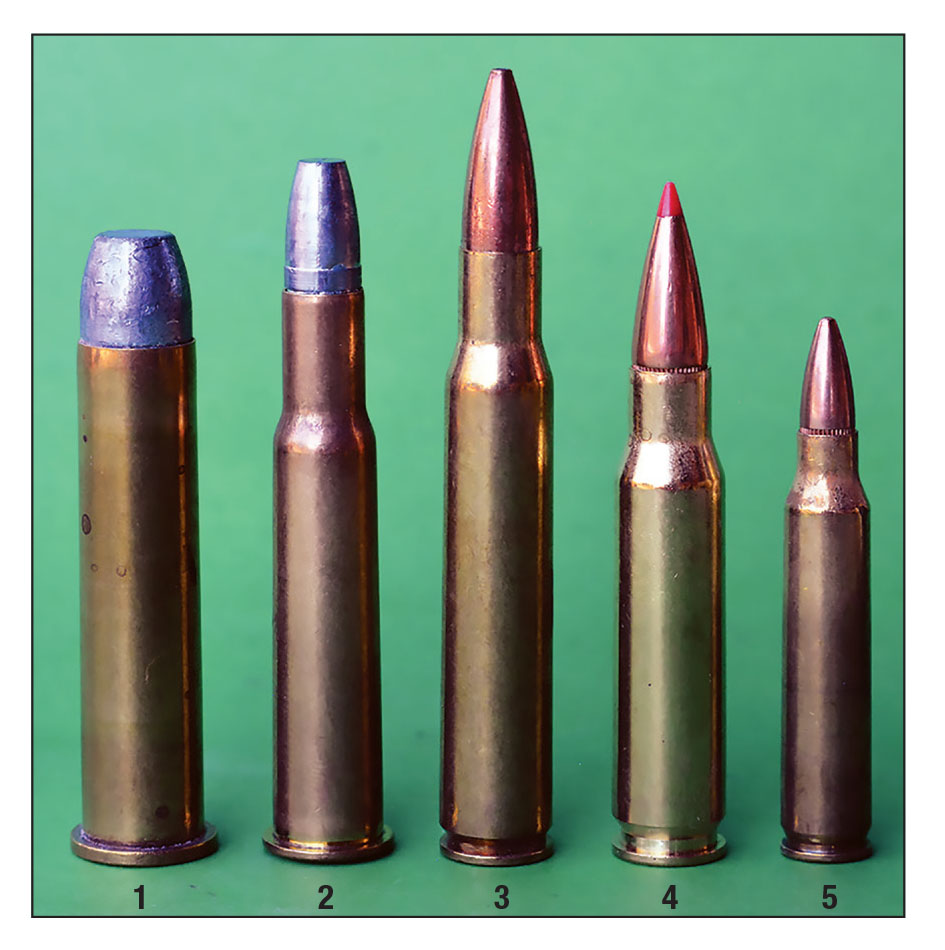
U.S. Military service cartridges include: (1) 45-70 Government, (2) 30-40 Krag, (3) 30-06 Springfield, (4) 308 Winchester and (5) 5.56 NATO (aka 223 Remington).
After a young firearms designer, John Browning, was discovered by Winchester and a deal was struck for the patents of what would become the Model 1885, the company President, T.G. Bennett, negotiated the patents of Browning’s first lever-action rifle that became the Model 1886 and easily housed the desirable 45-70 and other big-bore cartridges. This rifle was strong, robust, highly reliable, modern in every respect and became hugely popular for those needing a powerful repeater. Plus, the high-quality Winchester barrels produced similar accuracy as the renowned Marlin Ballard-style rifled barrels.
In the meantime, Marlin was busy developing a truly modern levergun with a compact, solid top receiver, flat bolt, side ejection, short throw lever principle and was constructed from robust solid forgings. This became the Model 1889 (later Model 1894 with minor improvements) that housed 44-40 Winchester-length cartridges, but that basic design was soon offered in the Model 1893 for 38-55 and 30-30-length cartridges. The above models are significant as they are essentially the same design that has been used on Marlin lever-action rifles to date. Finally, the above updated design was applied to the Model 1895 chambered in 45-70 and several other big-bore levergun cartridges and that competed favorably with the Winchester 1886.

Buffalo Bore Ammunition 45-70 loads (left) utilize a small rifle primer that serves to further help prevent magazine tube detonations. The Starline case (right) features a standard large rifle primer.
The problem was that by 1895, smokeless powders were already appearing in modern, small-bore U.S. rifle cartridges such as the 30 W.C.F. (aka 30-30), 30 U.S. (aka 30-40 Krag) and others. This resulted in waning sales of the big-bore leverguns chambered for black-powder cartridges. However, many big-game hunters taking grizzlies, moose and elk still found favor with the proven 45-70. But by 1915, Marlin discontinued the Model 1895 and Winchester Model 1886 sales were at an all-time low. From 1920 through 1936, when it was likewise discontinued, a total of just over 700 rifles were made. Both lever-action companies considered the 45-70 obsolete with no plans to continue production.
After World War II, demand from hunters and shooters for a big-bore levergun grew until Marlin introduced the Model 336-44 chambered in 44 Magnum in 1963. But more power was wanted, so Marlin joined with Remington to develop the 444 Marlin that was first offered in 1965. While sales were good, it was clear that there was still a strong demand for a rifle chambered in the proven 45-70 Government.

For repeating rifles with tubular magazines, bullets with flatnose profiles are preferred such as these vintage Winchester 405-grain softpoint loads (left), while cast bullets with roundnose profiles are generally preferred for single-shot rifles (right).
In 1972, Marlin finally succumbed and reintroduced the Model 1895 chambered in 45-70. However, this modern version featured a round bolt and other engineering changes to lighten the weight, increase strength and permitted higher pressure +P-style handloads (and was basically built on the 336 action) It featured a 22-inch barrel, four-round (2⁄3-length) magazine, cut-rifled barrel with 1:20 twist, straight stock with square finger lever and weighed around 7 pounds with an overall length of 40½-inches. For general hunting purposes, this Model 1895 configuration remains a personal favorite. Sales were instantly robust and it took many years for Marlin to catch up with demand. Variations of the Model 1895 have been regularly offered with a few notables including the Cowboy, Guide Gun, CB Carbine and SBL. Its success has been so significant over the past 50-plus years that when Ruger purchased Marlin and revamped production, based on a model that had the highest consumer demand, the Model 1895 SBL was the first rifle produced, even being more popular than rifles chambered for the 30-30 Winchester! Clearly, the demand is very strong.

There is an extensive selection of components for handloading the 45-70.
Winchester was still struggling with quality control and design issues with its post-’64 product line and could not reintroduce the Model 1886 to compete with Marlin’s 45-70 reintroduction. Browning Arms finally recognized the demand and in 1992, imported the Miroku-manufactured 1886 Rifle and Carbine. After Browning acquired USRAC, future Miroku Model 1886s bear the Winchester name and are still regularly imported. Italian importers are also offering some interesting Model 1886 reproductions.
Henry Repeating Arms is a relatively young company that offers more than a dozen leverguns chambered in 45-70. A few noteworthy models include the Big Boy and Side Gate Models that feature a brass receiver, round or octagonal barrels and black American walnut stock, while the X Model features a black stock, matte finish, integral cross-slots for lights and accessories, while the barrel is threaded for suppression options and other accessories. These guns are accurate and are 100 percent made in the U.S.
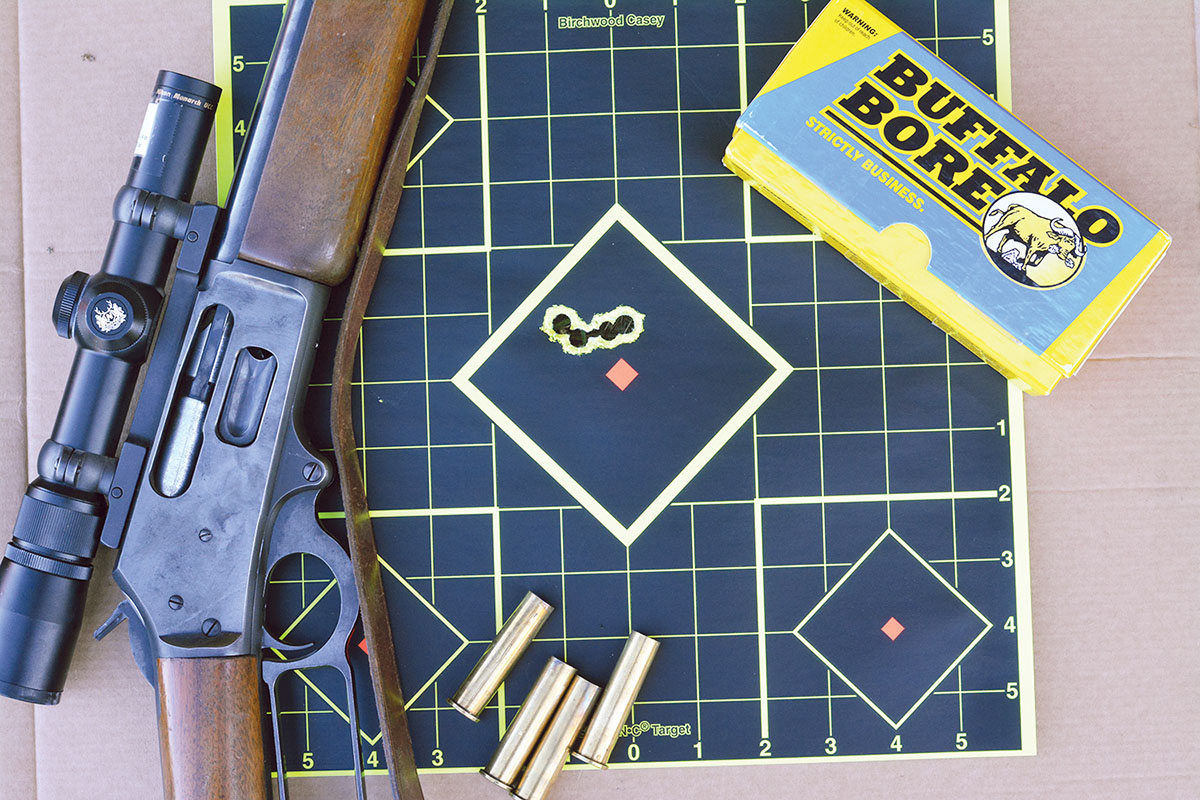
This early post-World War II Marlin Model 1895 has fired thousands of rounds and is a proven hunting rifle. This four-shot group was fired at 75 yards.
The number of outstanding single shots currently chambered in 45-70 is very lengthy, so only a few notables will be mentioned. The original Sharps Model 1874 was a highly respected rifle on the frontier and on target ranges and still is to this day! Shiloh Manufacturing and C. Sharps Arms (both in Montana) offer top-notch quality reproductions that are extremely well-made, accurate and can be special ordered with nearly endless options. Uberti also offers a Model 1874 Sharps reproduction that is a worthy rifle, especially considering its moderate price. Both Uberti and Miroku offer variations of the original Winchester Model 1885, which was John Browning’s first patented rifle. The Ruger No. 1 is an outstanding sporting rifle that has been chambered in 45-70 for several decades, but is now only available in limited production runs.
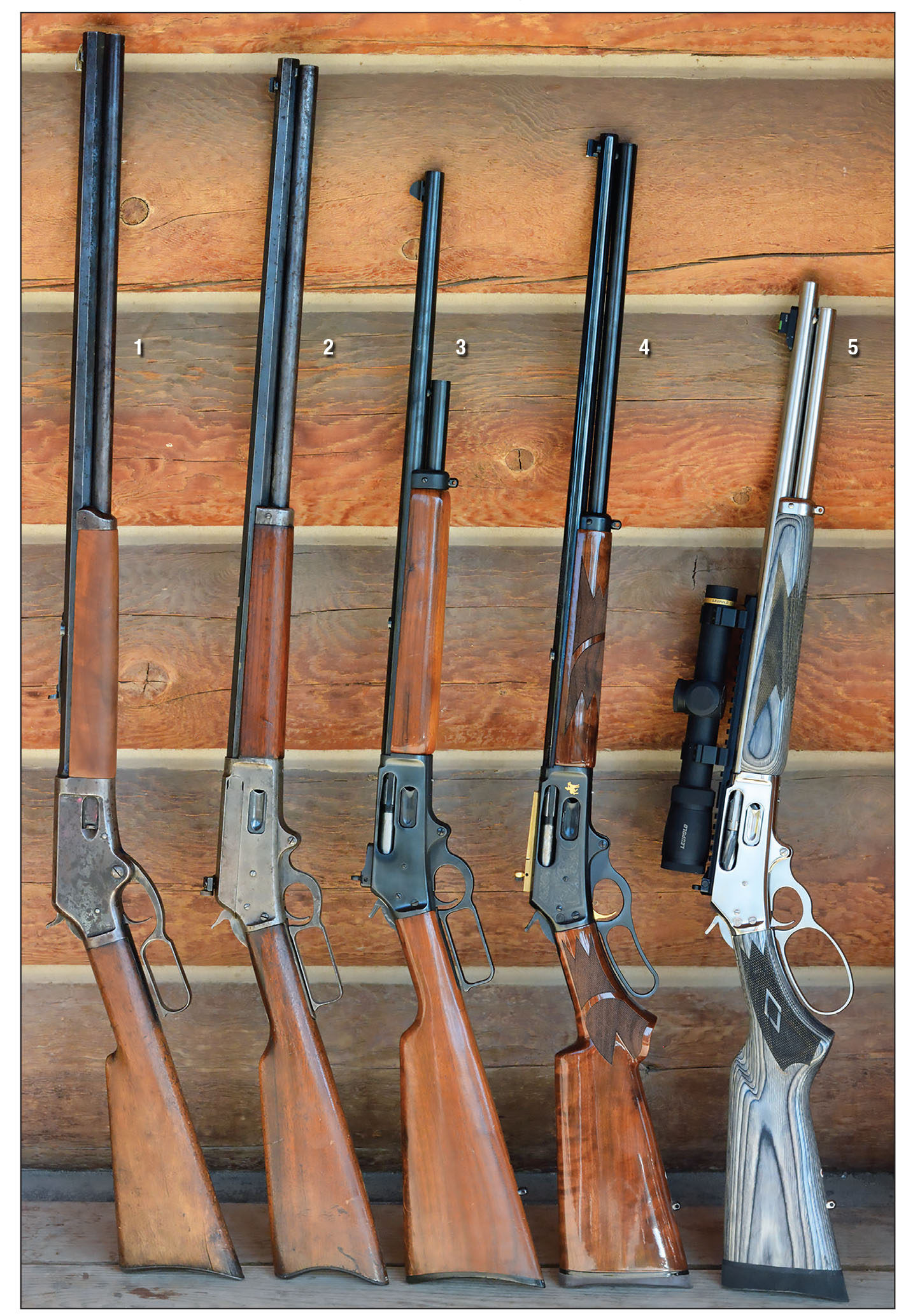
Marlin beat Winchester to the punch in offering a lever-action rifle chambered in 45-70 Government: (1) Marlin Model 1881, (2) original Marlin Model 1895, (3) 1972 era Model 1895, (4) Remington produced Marlin Model 1895 Limited Edition and (5) Ruger-produced Marlin Model 1895 SBL.
With so many different rifles, actions, etc. produced during the past 150 years, it has become common among handloaders to divide rifles into three basic categories regarding the strength and the load pressure level that each will handle. In essence, the Sporting Arms and Ammunition Manufacturers’ Institute (SAAMI) lists maximum average pressures at 28,000 psi/CUP (which is normally not the same, but in the 45-70, these figures are very close to each other). However, in deference to the U.S. 1873 trapdoor rifles, practically all factory loads from Black Hills, Federal, Winchester and Remington are hovering around 19,000 to 22,000 psi. While the original Marlin Model 1895 and Winchester Model 1886 lever actions are notably stronger than the trapdoor rifles, they are not as strong as their post-World War II counterparts and should generally be used with loads that are held to 28,000 psi. The modern Marlin Model 1895 and Miroku-manufactured Model 1886 are strong and can easily handle loads that generate 40,000 to 43,500 psi. From 22-inch barrels, this results in 405- to 430-grain bullets reaching 1,950 to 2,100 fps (depending on bullet type, powder, etc.). These loads are suitable for all game in North America and have become widely popular with Alaskan guides who must deal with wounded bears in the brush, pilots, or those who live in the bush and can wake up to a marauding bear. These loads are also suitable for African game including lion, Cape buffalo and hippo.
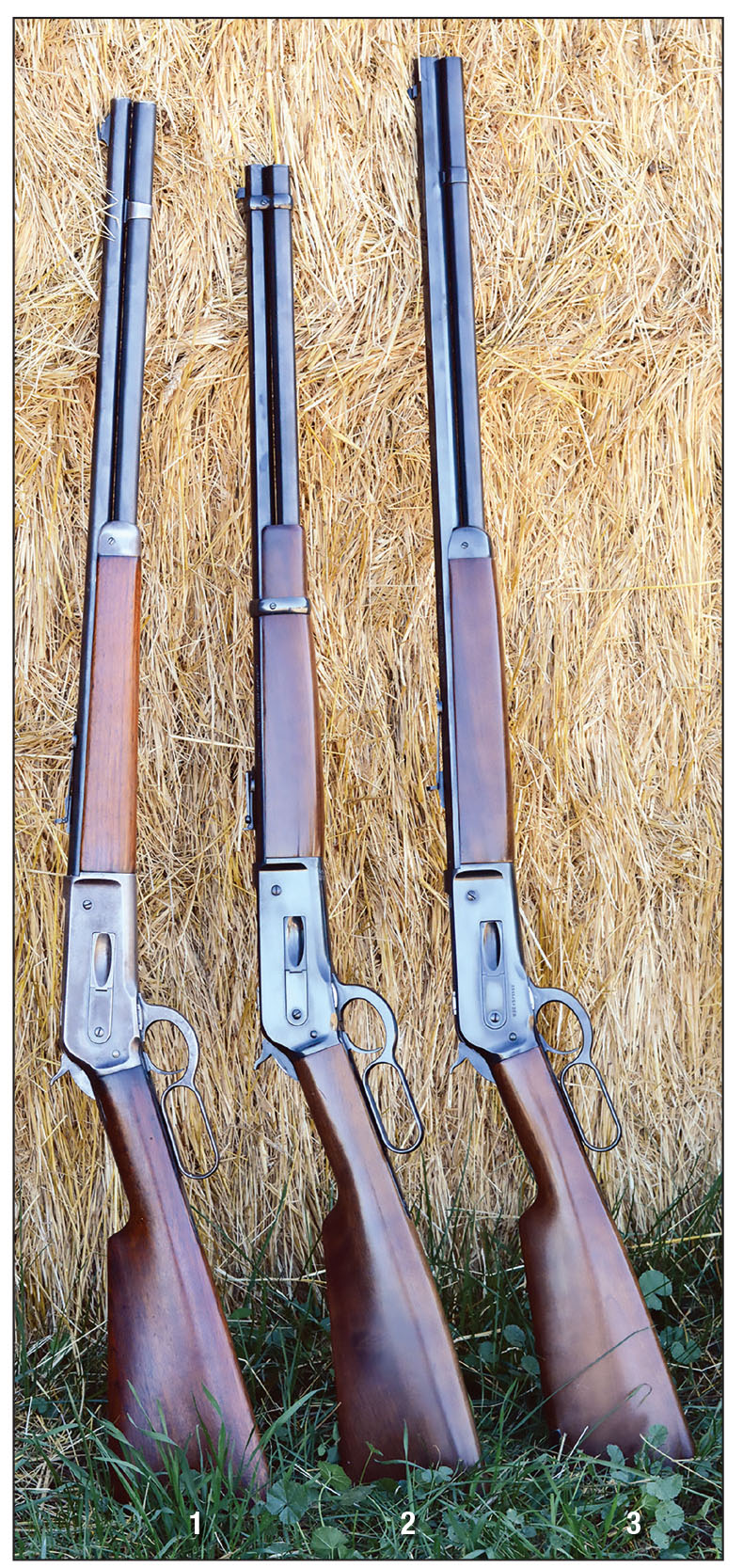
The Winchester Model 1886 was popular on the frontier and proved highly reliable and accurate: (1) original Winchester 1886, (2) Browning/Miroku 1886 Saddle Ring Carbine and (3) Browning Model 1886 rifle.
Since the beginning of smokeless powders in U.S. factory ammunition, Remington and Winchester primarily offered 45-70 Government smokeless loads with a 405-grain softpoint bullet at 1,320 to 1,330 fps, but a few decades back various 300-grain JHP/JSP bullets pushed to more than 1,800 fps were added. Naturally, all of the above loads operate at low enough pressure to be safe in all rifles. When cowboy action shooting became widely popular, companies such as Black Hills began offering 405-grain cast bullet loads at around 1,250 fps. Black Hills also offers a HoneyBadger load that contains a 325-grain monolithic bullet at 1,775 fps that stays within SAAMI pressure guidelines but offers remarkable terminal performance on game. Hornady has also modernized the 45-70 with a 325-grain FTX (rubber tip) spitzer-style bullet pushed to an impressive 2,000 fps and they offer a 410-grain Sub-X load at 1,075 fps, which is ideal for suppressed guns.
During the 1990s, several non-SAAMI companies began offering proprietary 45-70 loads that are suitable for the popular, modern lever actions, primarily Marlin rifles. These loads contain high-performance cast bullets, solids, and various jacketed bullets (typically from 350 to 500 grains) that are designed for hunting heavy game and have proven highly effective. Examples include Buffalo Bore, Garrett Cartridges and several others. In my testing, most of these loads are running from 30,000 psi to 44,000 psi and should only be used in suitable rifles.
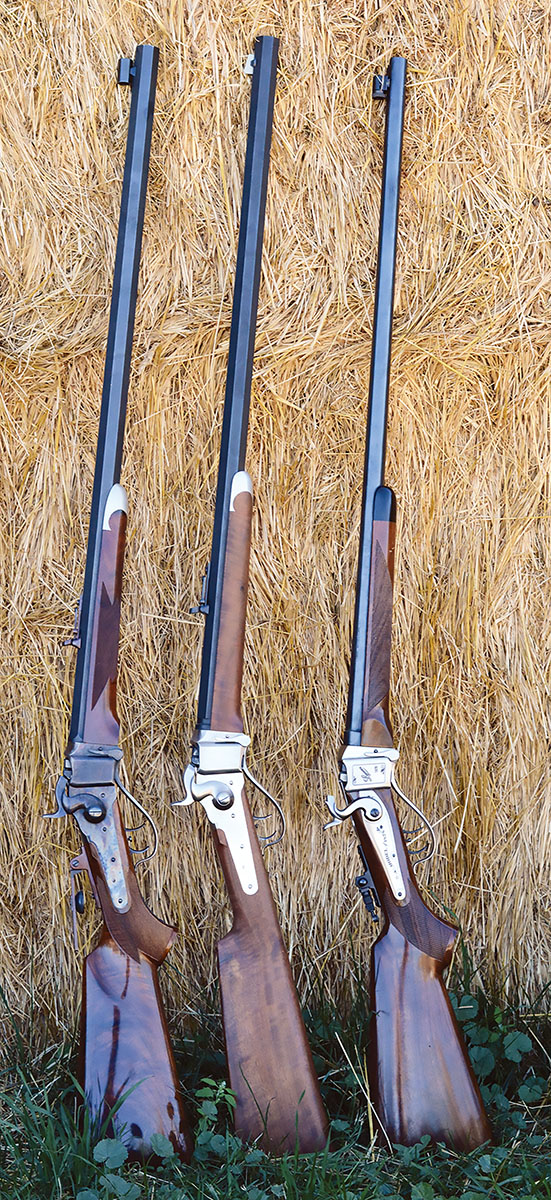
Modern reproductions of the famous Sharps rifles are available from Shiloh, C. Sharps Arms and Lyman/Pedersoli.
On a more personal note, I first acquired a Marlin Model 1895 back in the 1970s, which was shot extensively with heavy handloads containing cast bullets and appropriate charges of IMR-3031 powder. In the years since, I have owned, tested or hunted with practically every model of 45-70 rifle in existence including double rifles. I have a deep respect for this cartridge including its accuracy, performance on game and the top-quality rifles that it has been offered in. It has earned a place in my heart and has been used to take most of North America’s big game. I have even used it in Africa culling many animals. Despite the professional hunter being skeptical at first, after a few days of watching the results and never having to “clean-up” after me, he entirely stopped carrying his own rifle, as he knew when that old Marlin fired, the game was going down for good! Regardless of the application, it is important to match the load and bullet to the task at hand and with the corresponding barrel twist rate for proper bullet stabilization. With the correct choices, the 45-70 will not disappoint.
With 150 years passing since 1873, the 45-70 remains in very high demand. Certainly part of this popularity is due to nostalgia and its vital role in western U.S. history, but it has transitioned gracefully to smokeless powders and modern bullets. It is a truly great cartridge that can stand on its own merits and with a huge variety of firearms and ammunition available for target work, hunting and defense, it has a very bright future.

The U.S. Springfield 1873 trapdoor is a significant rifle in firearms history and was the rifle that the 45-70 Government was developed for. It proved accurate and reliable on the western frontier.














.jpg)
.jpg)
.jpg)
.jpg)


